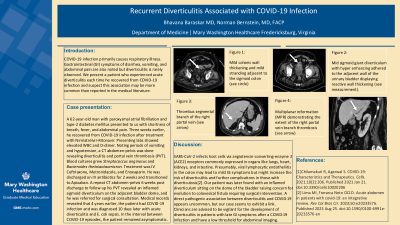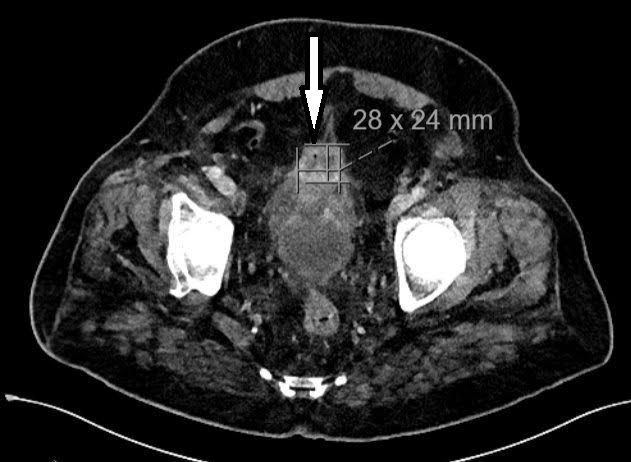Monday Poster Session
Category: Colon
P1992 - Recurrent Diverticulitis Associated With COVID-19 Infection
Monday, October 28, 2024
10:30 AM - 4:00 PM ET
Location: Exhibit Hall E

Has Audio

Bhavana Baraskar, MD
Mary Washington Hospital
Fredericksburg, VA
Presenting Author(s)
Bhavana Baraskar, MD, Norman Bernstein, MD
Mary Washington Hospital, Fredericksburg, VA
Introduction: COVID-19 infection primarily causes respiratory illness. Gastrointestinal (GI) symptoms of diarrhea, vomiting, and abdominal pain are also noted but diverticulitis is rarely observed. We present a patient who experienced acute diverticulitis each time he recovered from COVID-19 infection and suspect this association may be more common than reported in the medical literature.
Case Description/Methods: A 62-year-old man with paroxysmal atrial fibrillation and type-2 diabetes mellitus presented to us with shortness of breath, fever, and abdominal pain. Three weeks earlier, he recovered from COVID-19 infection after treatment with Nirmatrelvir-Ritonavir. Presenting labs showed elevated WBC and D-dimer. Noting periods of vomiting and hypotension, a CT abdomen-pelvis was done revealing diverticulitis and portal vein thrombosis (PVT). Blood cultures grew Streptococcus anginosus and Bacteroides thetaiaotaomicron. Treatment was IV Ceftriaxone, Metronidazole, and Enoxaparin. He was discharged on IV antibiotics for 2 weeks and transitioned to Apixaban. A repeat CT abdomen-pelvis 6 weeks post discharge to follow up his PVT revealed an inflamed sigmoid diverticulum on the adjacent bladder dome, and he was referred for surgical consultation. Medical records revealed that 4 years earlier, the patient had COVID-19 infection and was diagnosed 10 days later with acute diverticulitis and E. coli sepsis. In the interval between COVID-19 episodes, the patient remained asymptomatic.
Discussion: SARS-CoV-2 infects host cells via angiotensin-converting-enzyme 2 (ACE2) receptors commonly expressed in organs like lungs, heart, kidneys, and intestine. Presumably, viral lymphocytic endotheliitis in the colon may lead to mild GI symptoms but might increase the risk of diverticulitis and further complications in those with diverticulosis. Our patient was later found with an inflamed diverticulum sitting on the dome of the bladder raising concern for evolution to colovesical fistula requiring surgical intervention. A direct pathogenic association between diverticulitis and COVID-19 appears uncommon but our case seems to exhibit a link. Clinicians are advised to be vigilant for the development of diverticulitis in patients with late GI symptoms after a COVID-19 infection and have a low threshold for abdominal imaging.

Disclosures:
Bhavana Baraskar, MD, Norman Bernstein, MD. P1992 - Recurrent Diverticulitis Associated With COVID-19 Infection, ACG 2024 Annual Scientific Meeting Abstracts. Philadelphia, PA: American College of Gastroenterology.
Mary Washington Hospital, Fredericksburg, VA
Introduction: COVID-19 infection primarily causes respiratory illness. Gastrointestinal (GI) symptoms of diarrhea, vomiting, and abdominal pain are also noted but diverticulitis is rarely observed. We present a patient who experienced acute diverticulitis each time he recovered from COVID-19 infection and suspect this association may be more common than reported in the medical literature.
Case Description/Methods: A 62-year-old man with paroxysmal atrial fibrillation and type-2 diabetes mellitus presented to us with shortness of breath, fever, and abdominal pain. Three weeks earlier, he recovered from COVID-19 infection after treatment with Nirmatrelvir-Ritonavir. Presenting labs showed elevated WBC and D-dimer. Noting periods of vomiting and hypotension, a CT abdomen-pelvis was done revealing diverticulitis and portal vein thrombosis (PVT). Blood cultures grew Streptococcus anginosus and Bacteroides thetaiaotaomicron. Treatment was IV Ceftriaxone, Metronidazole, and Enoxaparin. He was discharged on IV antibiotics for 2 weeks and transitioned to Apixaban. A repeat CT abdomen-pelvis 6 weeks post discharge to follow up his PVT revealed an inflamed sigmoid diverticulum on the adjacent bladder dome, and he was referred for surgical consultation. Medical records revealed that 4 years earlier, the patient had COVID-19 infection and was diagnosed 10 days later with acute diverticulitis and E. coli sepsis. In the interval between COVID-19 episodes, the patient remained asymptomatic.
Discussion: SARS-CoV-2 infects host cells via angiotensin-converting-enzyme 2 (ACE2) receptors commonly expressed in organs like lungs, heart, kidneys, and intestine. Presumably, viral lymphocytic endotheliitis in the colon may lead to mild GI symptoms but might increase the risk of diverticulitis and further complications in those with diverticulosis. Our patient was later found with an inflamed diverticulum sitting on the dome of the bladder raising concern for evolution to colovesical fistula requiring surgical intervention. A direct pathogenic association between diverticulitis and COVID-19 appears uncommon but our case seems to exhibit a link. Clinicians are advised to be vigilant for the development of diverticulitis in patients with late GI symptoms after a COVID-19 infection and have a low threshold for abdominal imaging.

Figure: CT abdomen-pelvis showing mid sigmoid giant diverticulum with hyper enhancing wall adhered to the adjacent wall of the urinary bladder and mild surrounding fat stranding supporting active inflammation.
Disclosures:
Bhavana Baraskar indicated no relevant financial relationships.
Norman Bernstein indicated no relevant financial relationships.
Bhavana Baraskar, MD, Norman Bernstein, MD. P1992 - Recurrent Diverticulitis Associated With COVID-19 Infection, ACG 2024 Annual Scientific Meeting Abstracts. Philadelphia, PA: American College of Gastroenterology.
